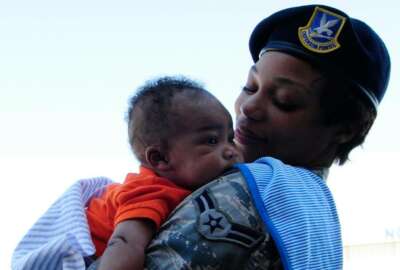
Aid entities say they expect military families will start applying for help now that financial realities are setting in.
The main sources of emergency relief funding for service members and their families are expecting a surge of requests in response to COVID-19.
Organizations like Army Emergency Relief, the Air Force Aid Society, Coast Guard Mutual Assistance and the Navy-Marine Corps Relief Society — all of which rely on donations to serve troops — say they have provided assistance to some military families in response to the disease; however, they expect the worst to come.
“With bills coming due I think we will start to see a cycle of folks realizing exactly what they’re going to need,” John Hopper, CEO of the Air Force Aid Society, said Tuesday during a virtual panel hosted by Blue Star Families and the Association of Defense Communities. “The relatively low demand you see for support in the beginning is sort of typical of disasters in that folks can’t assess and understand what they need in the midst of the badness going on.”
The relief organizations are providing assistance in response to COVID-19 in the form of loans and grants for childcare, housing, food, funeral expenses, lost wages and other issues.
Coast Guard Mutual Assistance CEO Cari Thomas said her organization has so far provided support for about 95 members of the Coast Guard, providing more than $200,000.
“We’re prepared for the long haul in whatever assistance may be needed as long as will be necessary,” Thomas said.
Army Emergency Relief (AER) has helped almost 60 soldiers and families in about $100,000 of aid regarding the coronavirus crisis.
“What we’re seeing the demand for is the Defense Department’s stop move order as well as loss of spouse pay — that second income,” said Ray Mason, AER director. “We think that’s going to grow once people kind of figure out where they are when the bills start coming in and we’re preparing for that right now.”
AER also started additional support for National Guard and Reserve members who are not called up under title 10 and have left their jobs to deploy, but are not getting the pay and benefits they need.
The Navy-Marine Corps Relief Society has provided the most relief so far, offering $217,000 to more than 300 active duty, retirees, reservist, retirees and family members.
The organizations are making it easier for service members to access loan applications by putting resources online.
Emergency relief organizations can only provide loans up to certain amounts. For example, AER’s quick loan option only provides $2,000.
Last week, a group of bipartisan lawmakers called on DoD to find more relief options or to increase the caps on relief loans during the military stop move order.
A letter to Defense Secretary Mark Esper asks DoD to issue “guidance and resources needed to ensure care and support to every military member and family adversely affected by this order.”
The letter goes on to say, “We strongly urge you to issue guidance allowing commanders to use the greatest possible breadth of relief options for these families and to further empower commanders to coordinate with traditional and non-traditional partners that may rapidly address the needs of these families.”
Those include commands, military family support organizations, charities, non-profits, state and local governments, community support efforts and all available relief funds.
The lawmakers say the grants and loans afforded to military families through the service relief funds are not enough to help families in this situation.
“Under current policy, Army families are limited to a maximum of $1,500 to offset their expenses while they wait to PCS,” the letter states. “Given the scope of the problem, we are concerned about the limited capacity installation commanders and organizations like the Airmen and Family Readiness Centers have to address these claims. This unparalleled order issued to save lives has led to an unparalleled need for assistance, critically straining the staff and resources available and inevitably resulting in long delays before relief reaches military families.”
Copyright © 2025 Federal News Network. All rights reserved. This website is not intended for users located within the European Economic Area.
Scott Maucione is a defense reporter for Federal News Network and reports on human capital, workforce and the Defense Department at-large.
Follow @smaucioneWFED

